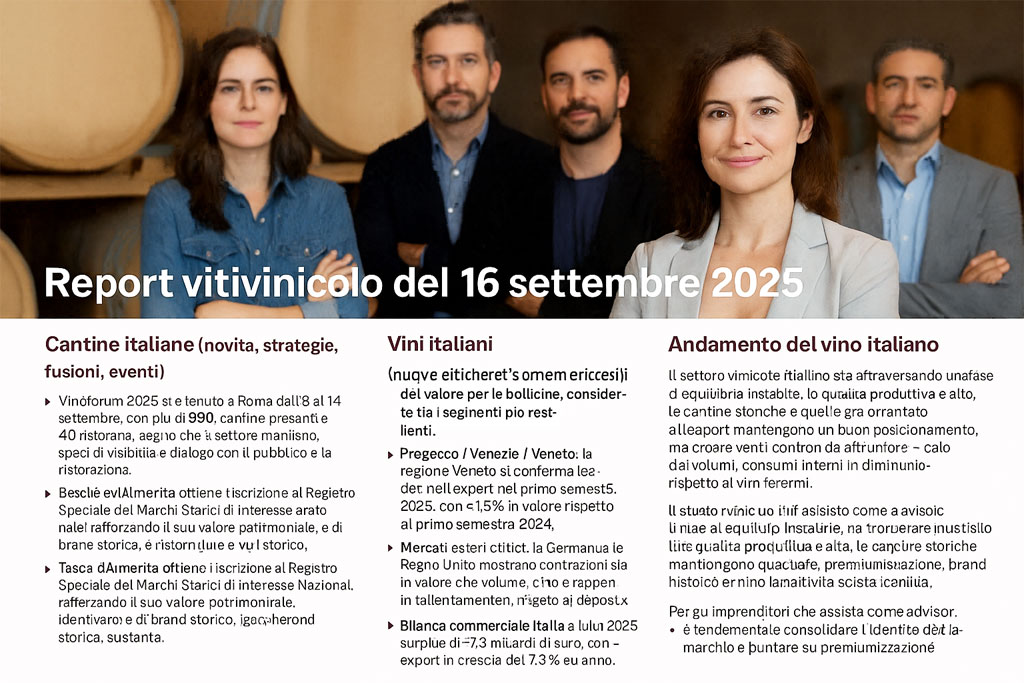Italian wineries (news, strategies, mergers, events).
Today’s Italian wine news:
- Vinòforum 2025 was held in Rome from September 8th to 14th, with more than 800 wineries and 40 restaurants present, a sign that the sector maintains spaces for visibility and dialogue with the public and the restaurant industry.
- 2025 harvest: in many areas (Chianti, Valpolicella, Valle d’Aosta, Colli Euganei, Conegliano-Valdobbiadene) the grape quality is particularly good, with good acidity and freshness, but uncertainties related to the market and duties continue to create uncertainty.
- Tasca d’Almerita has been registered in the Special Register of Historic Brands of National Interest, strengthening its heritage, identity, and historic brand value.
- Some leading wineries maintain strong export positions: for example, companies like Fantini Group, Ruffino, among the most exposed to foreign markets, a sign that those with already international structures continue to play an advantage.
Italian wines (new labels, awards, trends)
- Sparkling wines: confirmation of the growth trend in value for bubbles, considered among the most resilient segments.
- Prosecco / Venezie / Veneto: The Veneto region confirmed its leadership in exports in the first half of 2025, with a 1.5% increase in value compared to the first half of 2024, despite an overall slight decline.
- There’s a growing focus on quality, territory, and local identity as competitive levers: several reports have made it clear that simply having good grapes isn’t enough; you need storytelling, distinctiveness, a strong brand, and sustainability.
Italian wine trends (exports, consumption, economic data)
- Exports for the first half of 2025 : valued at around €3.867 billion , almost stable compared to the same period in 2024 (-0.47%) but with a drop in volumes of around -3.1%. Veneto, Tuscany, and Piedmont account for approximately 66.6% of total exports.
- Domestic consumption remains under pressure: even though the harvest looks set to be high-quality, domestic consumption continues to decline, partly due to changes in habits and partly due to price perceptions/economic factors.
- Forecasts among major producers: despite the current difficulties, there is moderate optimism for 2025, with expectations of growth in overall sales (1.7%), increasing exports (2%), and sparkling wines performing better than still wines.
- Italy’s trade balance as of July 2025: surplus of ~7.9 billion euros, with exports growing 7.3% year-over-year; the agri-food sector, including beverages, contributes 6.1%. This positive macroeconomic environment can provide a boost to the wine sector if well-integrated into corporate strategies.
Final summary
The Italian wine sector is experiencing a period of unstable equilibrium : production quality is high, historic wineries and those already oriented towards exports maintain a good position, but there are headwinds to contend with—declining volumes, declining domestic consumption, tariffs, and instability in foreign markets.
For the entrepreneurs I assist as an advisor:
- it is essential to consolidate the brand identity and focus on premiumization;
- diversify foreign markets (not just traditional ones), mitigate geopolitical and tariff risks;
- control costs (production, logistics, marketing) and innovate in sustainability and communication;
- using events, certifications, and storytelling as operational, not just decorative, tools.
I remain available to prepare an international comparison tomorrow (e.g., France/Spain) or forecast scenarios for 2026-2027 relevant to acquisition or positioning strategies.


